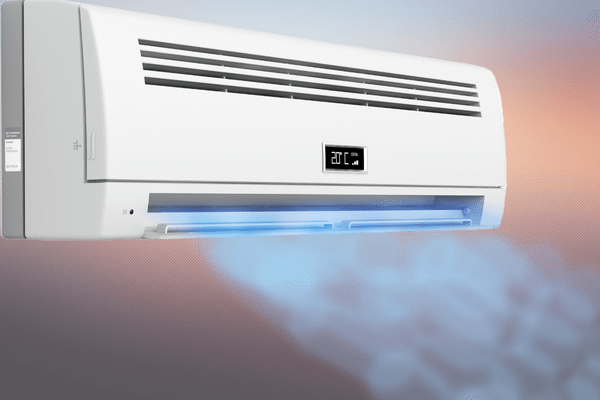Do Mini Splits Heat and Cool?
By My Service Depot on Monday, October 31, 2022Learn how a mini split system differs from a traditional central air HVAC system and how it could be a solution to your heating and cooling needs.
Yes! Mini split systems are heating AND cooling systems that don’t require any ductwork and operate without the need for ductwork. They have several cost advantages over traditional central HVAC systems, such as their lower installation and engineering costs.
Mini split units consist of both indoor and outdoor components. They work by utilizing both units to heat and cool the space effectively. The mini split system is mostly used to transport heat between two areas by way of refrigerant lines, which are easier to install than the ductwork required for central air units.
Cooling
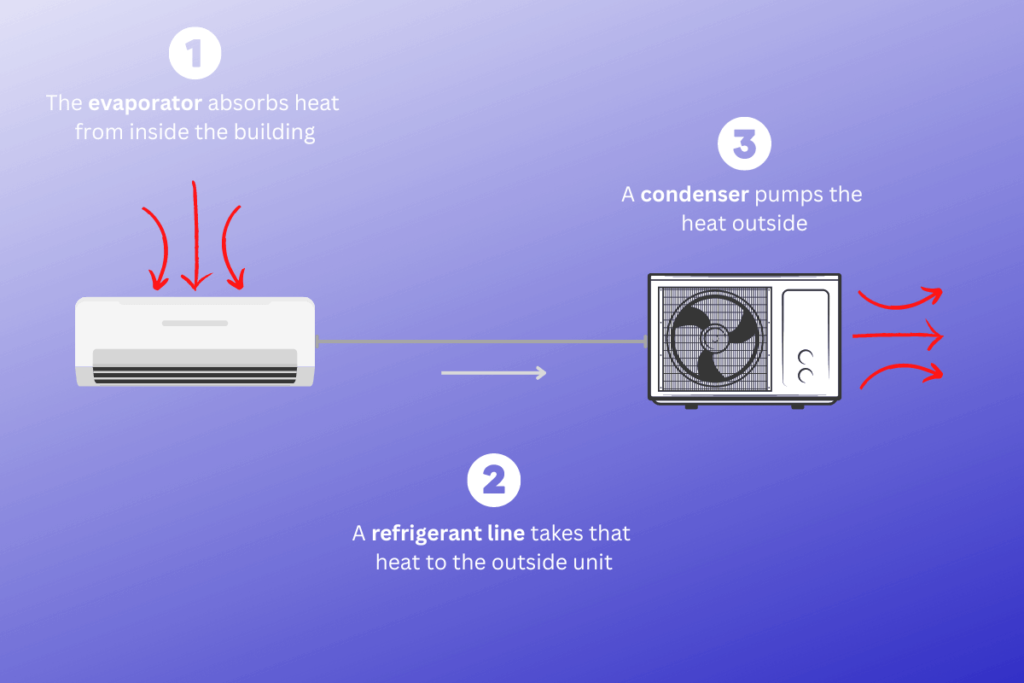
When cooling, the heat in the air is sent from inside your home through the refrigerant lines and compressed before being released outside. The process for heating is similar except that it takes the heat from outdoors and pumps it inside. This may not make too much sense for some because if it is 10 degrees outside, how does it get the heat from outdoors to pump inside the home? Well, even on a cold day there is still energy in the air.
Heating
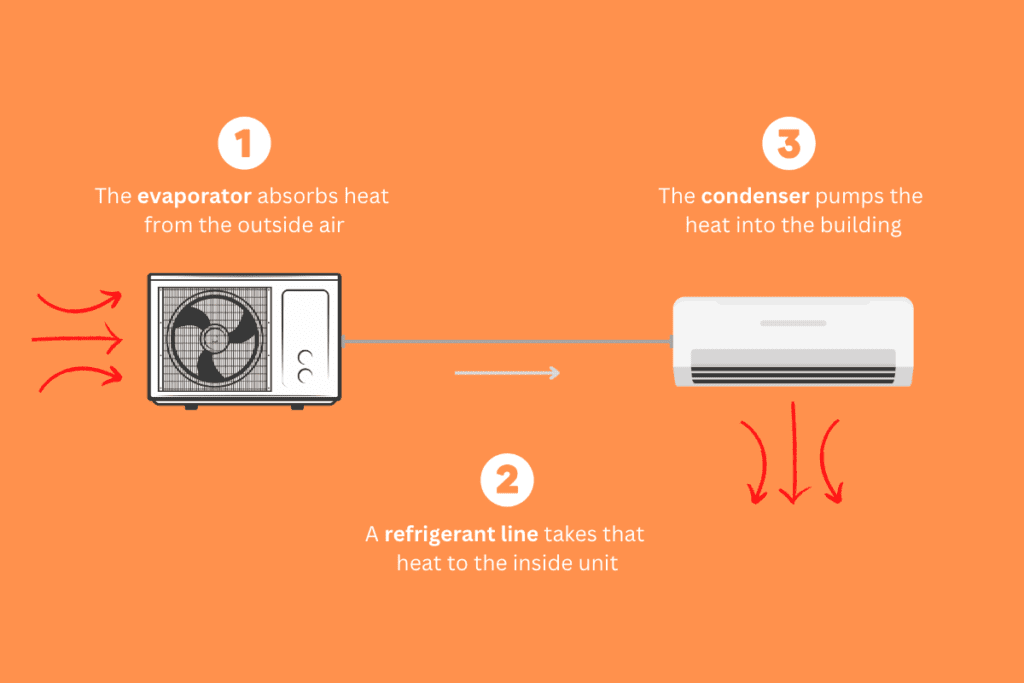
At a microscopic level, heat is just a bunch of molecules bouncing around. The heat pump captures the energy outside by offering it something even colder to flow into. It pushes refrigerant through an expansive valve in order to reduce pressure, which causes the boiling point to be reduced and the refrigerant to boil. This occurs in the evaporator of the unit.
From here, the refrigerant traveling into the home goes through the compressor causing an increase in pressure, which raises the boiling point. The gas is then changed into a liquid, causing energy to be released (heat into your home). For a more expansive overview of this process, check out this blog by carbonswitch.
Mini split systems can even heat or cool multiple rooms at a time by having multiple indoor units. These systems work very efficiently because they can be controlled individually, allowing you to turn off systems in unused rooms.
Pros of Mini Split Systems
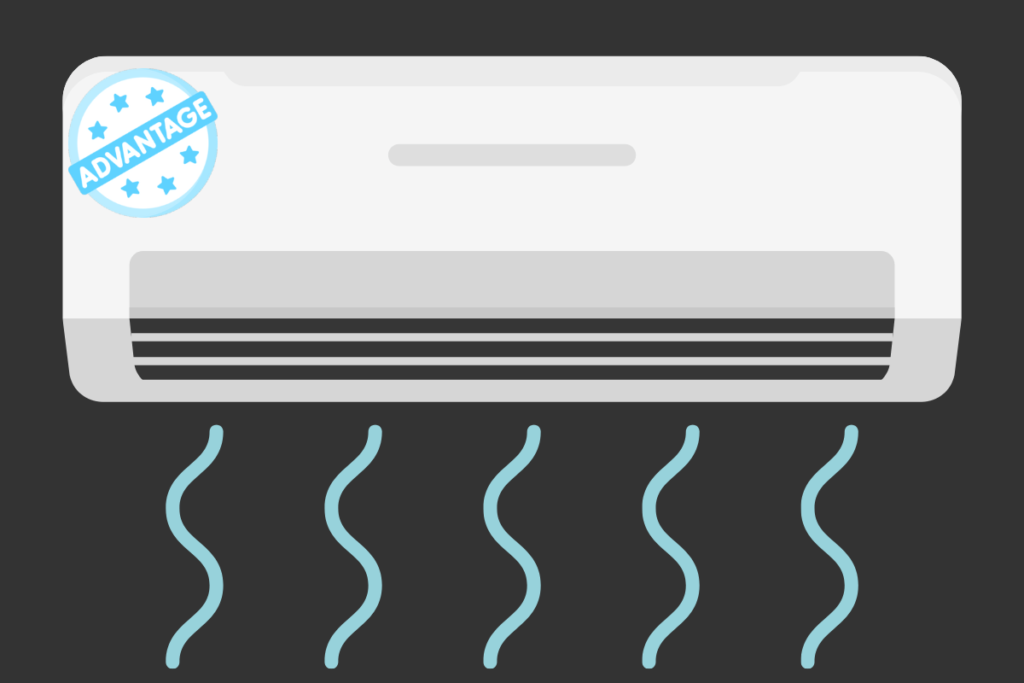
Mini splits offer a number of advantages over other types of HVAC systems. Some of the pros include:
Ease of Installation – since mini splits do not require ductwork, they are much easier to install than traditional HVAC systems.
Zoning Capability – mini splits can be divided into zones, which allows you to heat or cool only the spaces in your home that you need to. This can save you money by turning off the systems individually when they are not needed.
Energy Efficiency – mini splits use less electricity and are often more energy efficient than other types of HVAC systems because of their multiple zone control ability.
Wide Variety of Models – mini splits come in a wide variety of models, so you can find one that fits your needs and budget without much difficulty.
Improves Air Quality – more often than not the quality of indoor air is of much poorer quality than the air outside. With a typical HVAC system, the air ducts must be professional cleaned and maintained on a regular basis. Even still, with regular cleanings and all, dust and allergens are left behind. In a ductless mini split system it provides a multi-stage filtration that can drastically reduce dust, pollen, allergens and other harmful particulates in the air. Many of these units even have washable filters that you can clean and replace regularly.
Flexibility – you can choose from a number of different indoor and outdoor units to create the perfect system for your home. They also don’t require ductwork changes, which makes them a great option for remodeling projects.
Sound Reduction – mini split systems are much quieter than traditional systems, so you won’t have to worry about being disturbed by noise.
Cons of Mini Split Systems
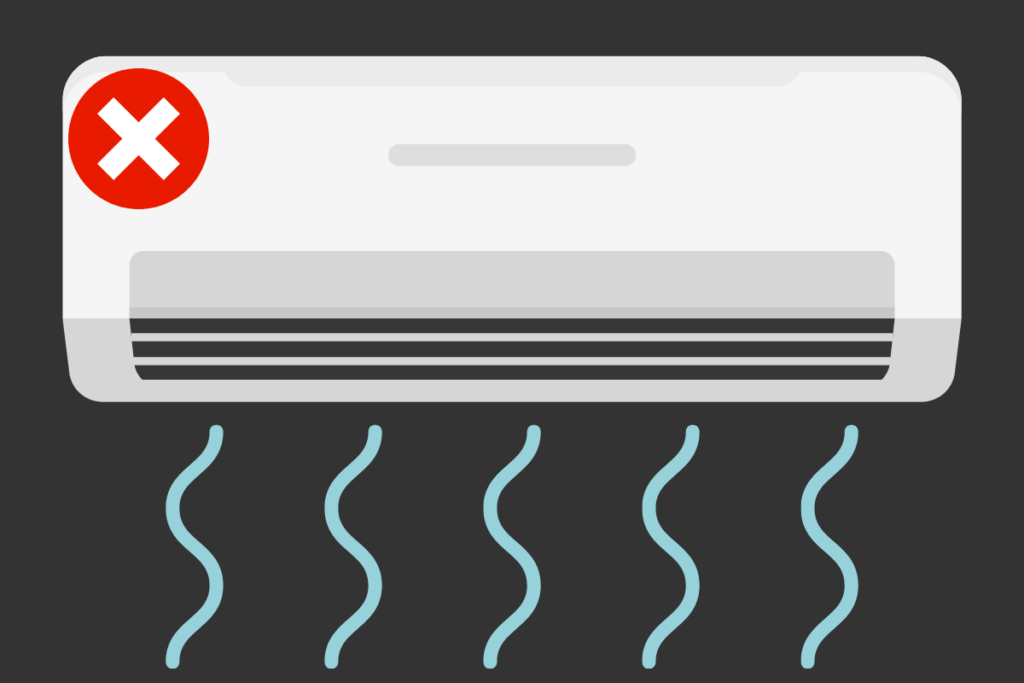
There are a few cons to consider before deciding if a mini-split is right for you. Some of the potential cons include:
Higher Initial Cost – mini splits can be more expensive to install than other types of HVAC systems.
Visual Appeal – These systems have to sit inside the home on the wall which can be an eyesore if you are big into decorating, even though they can be decorated around.
Not Always Suitable for Large Homes – mini splits are not always suitable for large homes, as they may not be able to provide enough cooling or heating power for large spaces or a vast amount of rooms.
Performance in Extreme Temperatures – Mini split systems work fantastic in moderate temperatures, but lose a great deal of efficiency when temperatures get below freezing or above 95-100 degrees. So be weary of this if you live in a region where temperatures fluctuate to extremes.
Maintenance – If you are someone that already struggles with replacing the filter in your forced air HVAC system, then a mini split system may not be for you. With forced air systems, the disposable filter typically needs to be replaced every 1, 3 or 6 months depending on the type of filter that you use. But with a mini split system, in order to keep it running efficiently, you need to clean the reusable filter monthly.
Mini Split Cost
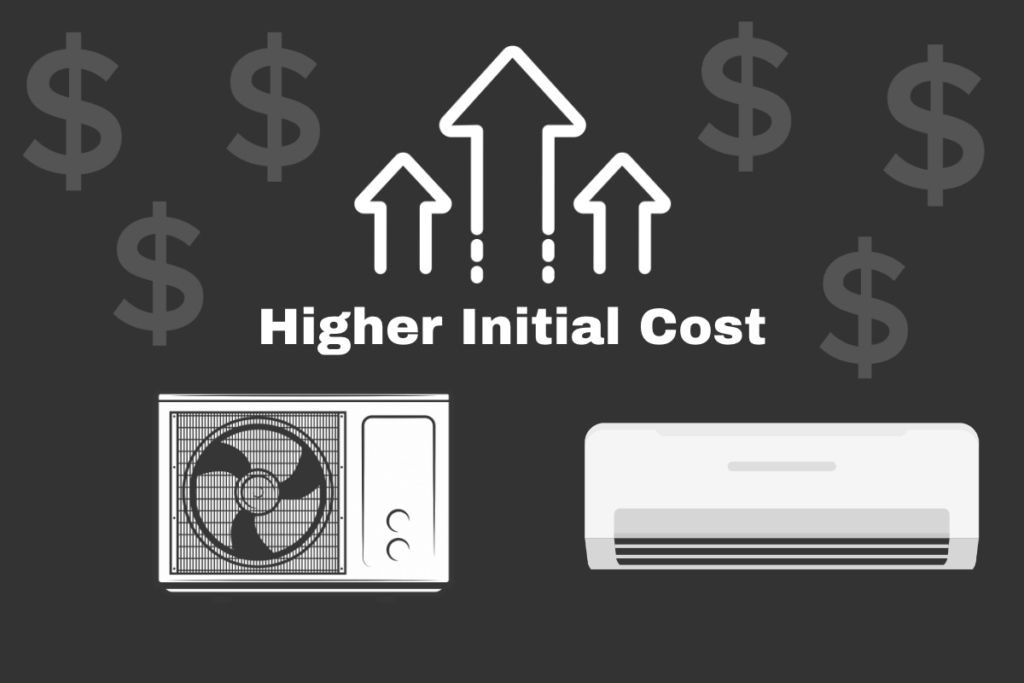
Although the initial price point is higher than other HVAC systems at about $5,000-$8,000 per zone, mini splits are more affordable in the long run. This is because their ductless design negates the need for costly and complicated ductwork that traditional central air units require. Installing refrigerant lines for a mini split system is much more simple than adding ductwork to a central air unit, reducing the overall cost.
With that being said, most people have multiple zones in their home, so for a full house to be equipped with a ductless system, it will likely cost $20,000 or more.
Even though they are more expensive to buy at first, mini split units are a wise investment because of their low installation cost, energy-efficient design, and zone control capability.
So the extra money used in the initial cost will be recouped by spending less on installation and by having lower energy bills. You can find a comprehensive cost breakdown on the Fire&Ice website.
Mini Split Maintenance
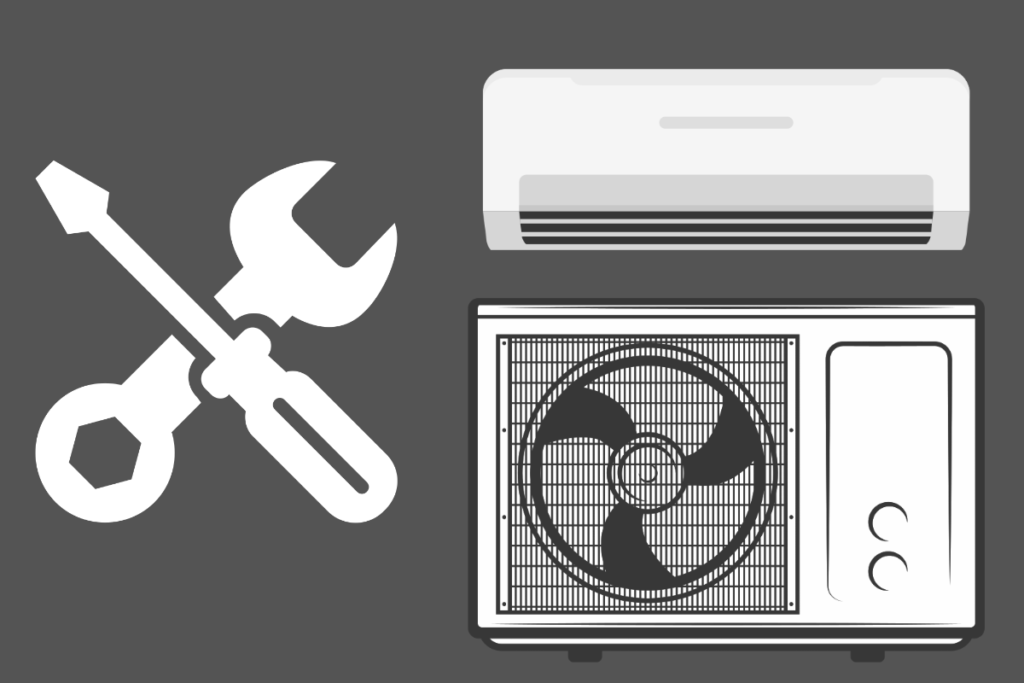
While these systems are relatively low-maintenance, there are a few things homeowners can do to keep them running smoothly.
- It’s important to keep the filters clean. Mini split systems have two filters – one on the indoor unit and one on the outdoor unit. The filters should be cleaned regularly (on a monthly basis) to ensure proper airflow.
- Make sure the outdoor unit is clear of any obstructions. Mini-splits work best when they have unobstructed airflow. If there is any obstruction blocking the unit, it may not work properly.
- It’s a good idea to inspect the seals on the indoor and outdoor units periodically. If the seals are damaged or broken, it could allow dirt and debris to enter the system, which could cause problems down the road.
Where to Purchase
If you’re in the market for a mini split heating and cooling system, there are a few things you need to keep in mind. Mini splits are a great option for homes that don’t have central air, or for people who want to zone their heating and cooling.
When shopping for a mini-split, it’s important to find a reputable dealer. Look for a dealer that has experience installing mini splits and that can properly size the unit for your home. You’ll also want to find a dealer that offers a good warranty.
Once you’ve found a dealer, you’ll need to decide what type of unit you want. There are two types of mini splits: ductless and ducted. Ductless mini splits don’t require any ductwork, while ducted mini splits do require some ductwork.
Finally, you’ll need to decide on a price point and select the system that best fits your budget. Then, take some measurements and determine what size unit will be the best fit for you and your home.
Can Mini Split Systems Be Used in Commercial Buildings?
Mini split systems are often used in residential buildings, but can they also be used in commercial buildings? The answer is yes – mini splits can be used for both heating and cooling in commercial buildings. Mini-splits are a great option for businesses because they are energy efficient and can save money on energy costs.
Additionally, mini splits are quiet and discreet, so they won’t disrupt the business environment. They can be used in a variety of settings, including office buildings, retail stores, and restaurants. The difference between a residential unit and a commercial unit will be the size. Generally the more heating and cooling you are doing the bigger the unit will need to be, this is especially true for larger buildings.
Why Are Mini Split Systems Growing in Popularity?
Mini split systems are growing in popularity because they offer homeowners many benefits over traditional HVAC systems. Some of this may be a reiteration of what we have previously mentioned, but we felt it deserved extra emphasis.
Mini splits are more energy efficient and use less electricity than traditional HVAC systems, which can save you a lot of money on your monthly energy bills.
Mini-splits are also versatile and can be installed in a variety of locations in your home. The installation process is also much easier because instead of complicated ductwork, all they require are refrigerant lines.
Mini splits offer more control to the home or business owner with the capability of zone control. Instead of setting the temperature to the entire home or building, you can set each room or ‘zone’ to a desired temp. If there is a room in your house that is unused, you can choose to not heat or cool that individual room and save additional money.
With mini splits having such a long list of benefits its no mystery why homeowners are switching to these types of systems.
Mini Split Installation
If you’re considering installing a mini split heating and cooling system in your home, here is what you need to know about the installation process.
First, you will need to have a qualified HVAC technician install the system. Mini splits must be installed by a professional, as they require specialized knowledge and equipment.
The installation process will involve running refrigerant lines from the outdoor unit to the indoor unit. The technician will also need to drill a hole in the wall or ceiling for the indoor unit. Once the system is installed, it will take a few hours for it to reach its full cooling or heating capacity.
Keep in Mine Before Buying a Mini Split System
A mini split system is a great option for those who are looking for an efficient and affordable way to heat and cool their home. However, before you buy a mini split system, there are some things you should know.
Mini split systems are more compact and efficient than traditional HVAC systems, and they can be installed in areas where a traditional HVAC system wouldn’t fit.
Additionally, mini split systems are typically more expensive than window air conditioners or portable air conditioners, but they offer more cooling power and are more energy efficient.
Another thing to keep in mind when purchasing a mini split system is the climate where you live. Mini split systems work best in climates where the temperature doesn’t vary too much throughout the year. If you live in a climate with extreme temperatures, a mini split system may not be the best option for you.
Before you buy a mini split system, be sure to consult with a professional HVAC installer to see if a mini split system is right for your home.
Conclusion
Mini split systems are becoming more and more popular because they offer homeowners a lot of benefits for their homes. These systems can efficiently heat and cool ‘zoned’ rooms in your home, which is a huge plus in the summer and winter months. They also have low costs associated with installation and don’t require a lot of maintenance (other than cleaning the filter monthly). If you want to start saving money on your energy bill, mini splits are the way to go!
If you are in the HVAC industry and are looking for more ways to save money and stay competitive, then look no further. Our Smart Service software can streamline your everyday work processes like scheduling, routing, and dispatching. Let Smart Service handle juggling these everyday tasks so you can focus more on the things that are truly important, like your customers!
You can even utilize the Smart Service mobile app iFleet to empower your field service technicians. The iFleet App will allow them to take pictures, update customer information, and take payment and job notes in the field, all in real-time!
If your business is looking for a boost, don’t hesitate and try a free software demo of Smart Service today. If you want to learn more about Smart Service, check out the Smart Service Hub.

